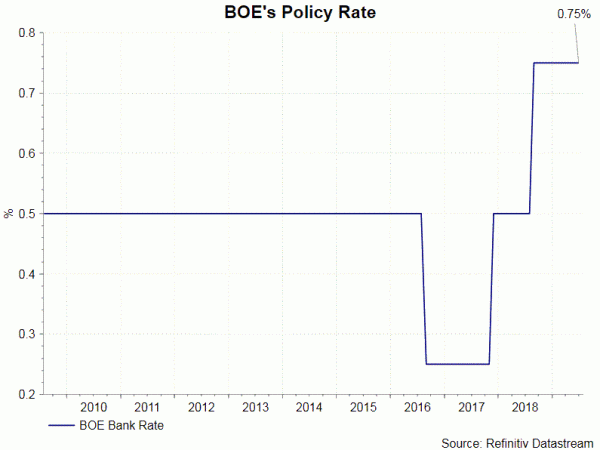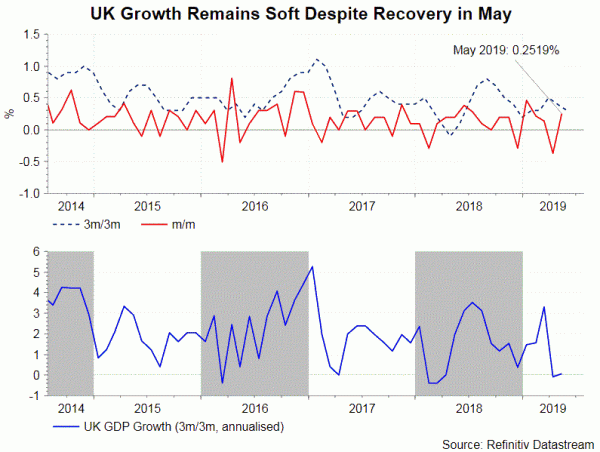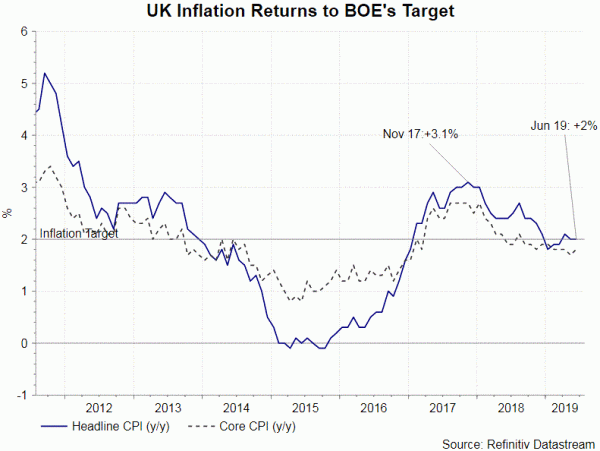We expect BOE to leave the Bank rate unchanged at 0.75% and keep the size of the asset purchase program at 435B pound. Heightened risk of no-deal Brexit, downside risks to economic outlook, market pricing of a rate cut later this year, and easing bias from the Fed and ECB should have tamed the hawkish members, leading the central bank to adopt a more neutral bias. The market has currently priced in 50% chance of a rate cut this year.
 UK’s economy grew +0.3% in the three months to May. However, modest recovery does not remove downside risks for the rest of the year. According to ONS, the moderate growth was driven by strength in IT, communications and retail. However, “there has been a longer-term slowdown in the often-dominant services sector since summer 2018”. For the month of May, GDP also expanded +0.3% from the prior month, following a -0.4% contraction in April. ONS suggested that the recovery was “mainly due to the partial recovery in car production”. PMIs in June were disappointing. Manufacturing PMI fell to 48, the lowest level since February 2013. Meanwhile, construction PMI plunged to 43.1, down from 48.6 in May. While staying marginally above 50, services PMI slipped -0.8 point to 50.2 in June, the lowest reading in three months. The subdued economic outlook does not only affect the economy in June or the second quarter. It signals a difficult time in third quarter. Headline inflation has been hovering about 2% in the first half of the year, markedly lower than the average levels in 2017 and 2018. This has greatly reduced the need to raise interest rate to curb inflation.
UK’s economy grew +0.3% in the three months to May. However, modest recovery does not remove downside risks for the rest of the year. According to ONS, the moderate growth was driven by strength in IT, communications and retail. However, “there has been a longer-term slowdown in the often-dominant services sector since summer 2018”. For the month of May, GDP also expanded +0.3% from the prior month, following a -0.4% contraction in April. ONS suggested that the recovery was “mainly due to the partial recovery in car production”. PMIs in June were disappointing. Manufacturing PMI fell to 48, the lowest level since February 2013. Meanwhile, construction PMI plunged to 43.1, down from 48.6 in May. While staying marginally above 50, services PMI slipped -0.8 point to 50.2 in June, the lowest reading in three months. The subdued economic outlook does not only affect the economy in June or the second quarter. It signals a difficult time in third quarter. Headline inflation has been hovering about 2% in the first half of the year, markedly lower than the average levels in 2017 and 2018. This has greatly reduced the need to raise interest rate to curb inflation.
 Indeed, the hawks have changed tone recently. Michael Saunders, one the most hawkish member, has pushed back on his rhetoric. As he suggested last week, “the economy right now is clearly not overheating – the underlying pace of growth, stripping out all of the funny effects, inventories, car shutdowns and so forth, is weak and below trend”. Chief Economist Andy Haldane also noted that the case for keeping policy unchanged is strong, despite vigilance about loosening.
Indeed, the hawks have changed tone recently. Michael Saunders, one the most hawkish member, has pushed back on his rhetoric. As he suggested last week, “the economy right now is clearly not overheating – the underlying pace of growth, stripping out all of the funny effects, inventories, car shutdowns and so forth, is weak and below trend”. Chief Economist Andy Haldane also noted that the case for keeping policy unchanged is strong, despite vigilance about loosening.
Strong inflation has caused BOE to maintain the view that the next move would be a rate hike. The central bank has been reiterating that, under the assumption of a smooth Brexit and that the economy continues to grow as expected, “an ongoing tightening of monetary policy over the forecast period, at a gradual pace and to a limited extent, would be appropriate to return inflation sustainably to the 2% target at a conventional horizon”. Given recent moderation in inflation and an intensified risk of no-deal Brexit, we are closely watching whether BOE would adjust the forecast that the next move would be “tightening”. We expect BOE to maintain this stance for now. A removal of the reference would certainly worsen the depreciation of sterling in the near-term.













